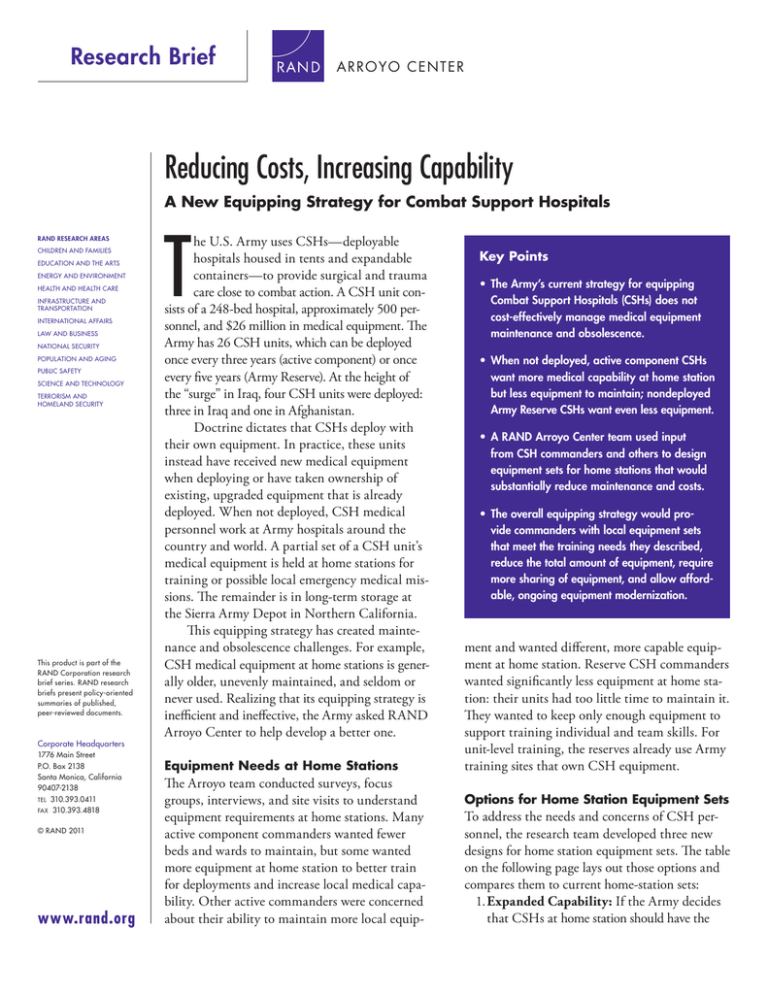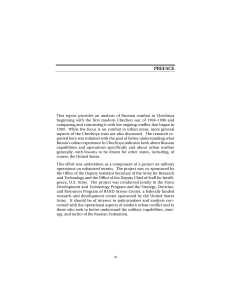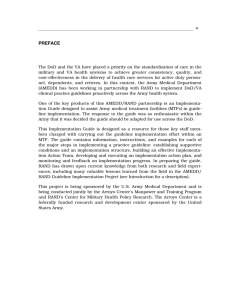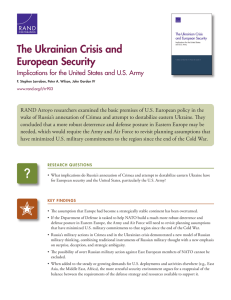T Reducing Costs, Increasing Capability
advertisement

Research Brief ARROYO CENTER Reducing Costs, Increasing Capability A New Equipping Strategy for Combat Support Hospitals RAND Research areas Children and Families Education and the Arts Energy and Environment Health and Health Care Infrastructure and Transportation International Affairs Law and Business National Security Population and Aging Public Safety Science and Technology Terrorism and Homeland Security This product is part of the RAND Corporation research brief series. RAND research briefs present policy-oriented summaries of published, peer-reviewed documents. Corporate Headquarters 1776 Main Street P.O. Box 2138 Santa Monica, California 90407-2138 Tel 310.393.0411 Fax 310.393.4818 © RAND 2011 www.rand.org T he U.S. Army uses CSHs—deployable hospitals housed in tents and expandable containers—to provide surgical and trauma care close to combat action. A CSH unit consists of a 248-bed hospital, approximately 500 personnel, and $26 million in medical equipment. The Army has 26 CSH units, which can be deployed once every three years (active component) or once every five years (Army Reserve). At the height of the “surge” in Iraq, four CSH units were deployed: three in Iraq and one in Afghanistan. Doctrine dictates that CSHs deploy with their own equipment. In practice, these units instead have received new medical equipment when deploying or have taken ownership of existing, upgraded equipment that is already deployed. When not deployed, CSH medical personnel work at Army hospitals around the country and world. A partial set of a CSH unit’s medical equipment is held at home stations for training or possible local emergency medical missions. The remainder is in long-term storage at the Sierra Army Depot in Northern California. This equipping strategy has created maintenance and obsolescence challenges. For example, CSH medical equipment at home stations is generally older, unevenly maintained, and seldom or never used. Realizing that its equipping strategy is inefficient and ineffective, the Army asked RAND Arroyo Center to help develop a better one. Equipment Needs at Home Stations The Arroyo team conducted surveys, focus groups, interviews, and site visits to understand equipment requirements at home stations. Many active component commanders wanted fewer beds and wards to maintain, but some wanted more equipment at home station to better train for deployments and increase local medical capability. Other active commanders were concerned about their ability to maintain more local equip- Key Points • The Army’s current strategy for equipping Combat Support Hospitals (CSHs) does not cost-effectively manage medical equipment maintenance and obsolescence. • When not deployed, active component CSHs want more medical capability at home station but less equipment to maintain; nondeployed Army Reserve CSHs want even less equipment. • A RAND Arroyo Center team used input from CSH commanders and others to design equipment sets for home stations that would substantially reduce maintenance and costs. • The overall equipping strategy would provide commanders with local equipment sets that meet the training needs they described, reduce the total amount of equipment, require more sharing of equipment, and allow affordable, ongoing equipment modernization. ment and wanted different, more capable equipment at home station. Reserve CSH commanders wanted significantly less equipment at home station: their units had too little time to maintain it. They wanted to keep only enough equipment to support training individual and team skills. For unit-level training, the reserves already use Army training sites that own CSH equipment. Options for Home Station Equipment Sets To address the needs and concerns of CSH personnel, the research team developed three new designs for home station equipment sets. The table on the following page lays out those options and compares them to current home-station sets: 1.Expanded Capability: If the Army decides that CSHs at home station should have the Options for Home Station Equipment Sets CSH Home Station Sets Equipment Set Total Current Operating tables 8 2 4 Trauma beds 8 4 8 Intensive care beds 48 24 24 Intermediate care beds 200 80 40 2 x-ray x-ray 2 x-ray 12 3 12 Large and small Small Large and small Full x-ray capability Hard shelters Pharmacy capability for broader training and more medical capability, it should adopt an “expanded” capability set with more local medical equipment. An expanded design has fewer total beds than the current design, but doubles the surgical and trauma capability. 2.Enhanced Capability: If active component CSHs can train more broadly elsewhere, such as at a regional training site, then the Army should adopt an “enhanced” design, providing even fewer beds but still improving local medical capabilities. 3.Lean Capability: The “lean” design would provide a very limited set of equipment sufficient to allow CSH personnel to train for certain core hospital functions. The lean design sends nearly all medical equipment to storage. Based on a risk analysis that considered maintenance, training, and local medical missions, Arroyo researchers recommended that the active component adopt the enhanced design and that the Army Reserve adopt a very lean equipment set at home station. Equipment Sets at Training Sites and in Storage The research team also made recommendations for CSH equipment at training sites and in storage. For training sites, the team recommends tailoring equipment sets for training exercises to the needs of specific CSHs. For the equipment at the Sierra Army Depot (about two dozen 164-bed hospitals and two full 248-bed hospitals), the Expanded Enhanced Lean 2 4 12 20 1 x-ray 12 Large 1 2 2 None 0 0 team recommends radically reducing the number of 164-bed sets, improving the condition and currency of the remaining sets, and shared ownership (i.e., CSH units would not retain a one-to-one correspondence between their home-station equipment set and sets in storage). Reduced Costs and Better Equipment The overall strategy proposed by Arroyo would substantially reduce the cost of equipping and maintaining the Army’s CSHs. Fewer full hospital sets systemwide mean less medical equipment. A detailed cost analysis conducted by the Arroyo team estimated that the total cost of CSH medical equipment sets would decrease from approximately $1 billion to about $740 million. The associated reduction in maintenance and upgrade costs will make it easier for the Army to ensure that the remaining equipment is well maintained and state of the art. Proposed Strategy Consistent with Broader Army Shift Senior Army leaders are concerned that the Army cannot afford to fully equip all units all the time. The proposed equipping strategy represents a radical departure from the current strategy, but is consistent with Army leaders’ increasing emphasis on performing more efficiently while still improving capabilities: “doing more with less.” The proposed strategy is a means to both ends: improving training and deployed capabilities while reducing costs through more efficient operations. ■ This research brief describes work done by the RAND Arroyo Center and documented in New Equipping Strategies for Combat Support Hospitals, by Matthew W. Lewis, Aimee Bower, Mishaw T. Cuyler, Rick Eden, Ronald E. Harper, Kristy Gonzalez Morganti, Adam C. Resnick, Elizabeth D. Steiner, and Rupa S. Valdez, MG-887-A, 2010 (available at http://www.rand.org/pubs/monographs/ MG887.html). This research brief was written by Susan K. Woodward. The RAND Corporation is a nonprofit institution that helps improve policy and decisionmaking through research and analysis. RAND’s publications do not necessarily reflect the opinions of its research clients and sponsors. R® is a registered trademark. RAND Offices Santa Monica, CA • Washington, DC • Pittsburgh, PA • New Orleans, LA/Jackson, MS • Boston, MA • Doha, QA • Abu Dhabi, AE • Cambridge, UK • Brussels, BE RB-9626-A (2011) CHILDREN AND FAMILIES EDUCATION AND THE ARTS The RAND Corporation is a nonprofit institution that helps improve policy and decisionmaking through research and analysis. ENERGY AND ENVIRONMENT HEALTH AND HEALTH CARE INFRASTRUCTURE AND TRANSPORTATION This electronic document was made available from www.rand.org as a public service of the RAND Corporation. INTERNATIONAL AFFAIRS LAW AND BUSINESS NATIONAL SECURITY POPULATION AND AGING PUBLIC SAFETY SCIENCE AND TECHNOLOGY TERRORISM AND HOMELAND SECURITY Support RAND Browse Reports & Bookstore Make a charitable contribution For More Information Visit RAND at www.rand.org Explore the RAND Arroyo Center View document details Research Brief This product is part of the RAND Corporation research brief series. RAND research briefs present policy-oriented summaries of individual published, peer-reviewed documents or of a body of published work. Limited Electronic Distribution Rights This document and trademark(s) contained herein are protected by law as indicated in a notice appearing later in this work. This electronic representation of RAND intellectual property is provided for noncommercial use only. Unauthorized posting of RAND electronic documents to a non-RAND website is prohibited. RAND electronic documents are protected under copyright law. Permission is required from RAND to reproduce, or reuse in another form, any of our research documents for commercial use. For information on reprint and linking permissions, please see RAND Permissions.





